
Badminton is a racquet sport played using racquets to hit a shuttlecock across a net. Although it may be played with larger teams, the most common forms of the game are "singles" and "doubles". Badminton is often played as a casual outdoor activity in a yard or on a beach; formal games are played on a rectangular indoor court. Points are scored by striking the shuttlecock with the racquet and landing it within the opposing side's half of the court.
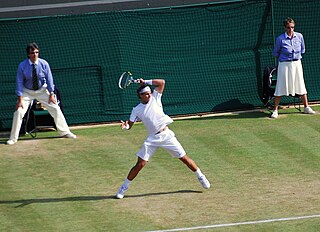
Tennis is a racket sport that can be played individually against a single opponent (singles) or between two teams of two players each (doubles). Each player uses a tennis racket that is strung with cord to strike a hollow rubber ball covered with felt over or around a net and into the opponent's court. The object of the game is to manoeuvre the ball in such a way that the opponent is not able to play a valid return. The player who is unable to return the ball validly will not gain a point, while the opposite player will.

Volleyball is a team sport in which two teams of six players are separated by a net. Each team tries to score points by grounding a ball on the other team's court under organized rules. It has been a part of the official program of the Summer Olympic Games since Tokyo 1964. Beach volleyball was introduced to the programme at the Atlanta 1996. The adapted version of volleyball at the Summer Paralympic Games is sitting volleyball.

Beach volleyball is a team sport played by two teams of two players on a sand court divided by a net. Similar to indoor volleyball, the objective of the game is to send the ball over the net and to ground it on the opponent's side of the court. Each team works in unison to prevent the opposing team from grounding the ball on their side of the court.
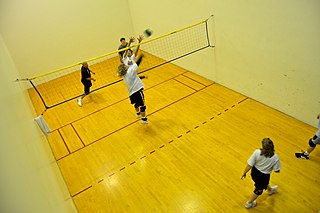
Wallyball is a fast-paced sport that is similar to volleyball played in a racquetball court, where it is legal to hit the ball off of the walls.

Pickleball is a racket sport that combines elements of tennis, badminton, and table tennis. Two or four players use solid paddles made of wood or composite materials to hit a perforated polymer ball over a net. The ball is much like a wiffle ball, with 26–40 round holes. The sport shares features of other racket sports: a net similar to tennis, a court similar to badminton, and a paddle similar to table tennis.
This page is a glossary of tennis terminology.
Players use different strategies while playing tennis to enhance their own strengths and exploit their opponent's weaknesses in order to gain the advantage and win more points.
Hoover ball is a medicine ball game invented by President Herbert Hoover's personal physician, Medal of Honor recipient Joel T. Boone, to help keep then-President Hoover fit. The Hoover Presidential Library Association and the city of West Branch, Iowa co-host a national championship each year.
Biribol is a sport, which resembles an aquatic variation of volleyball. It has originated in Brazil, in the city of Birigüi, in the 1960s by Prof. Dario Miguel Pedro. It showed up as a group game and as an alternative to the practice and the learning of swimming.
This is a list of the more common English volleyball jargon terms:
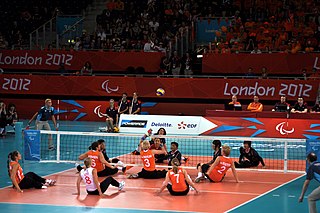
Sitting volleyball is a form of volleyball for athletes with a disability. As opposed to standing volleyball, sitting volleyball players must have at least one buttock in contact with the floor during the game.
Several sports related to volleyball have become popular. Indoor volleyball and beach volleyball are both events at the Olympics, and sitting volleyball is an event at the Paralympics. Other varieties are localised, or are played at an amateur or informal level.
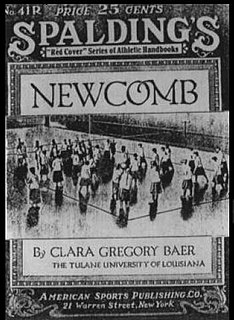
Newcomb ball is a ball game played as a variation of volleyball.
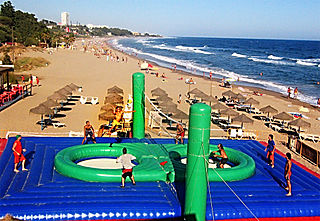
Bossaball is a team sport that originated in Spain and was conceptualised by Belgian Filip Eyckmans in 2005. Bossaball is a ball game between two teams, combining elements of volleyball, football and gymnastics with music into a sport. It is played on an inflatable court featuring a trampoline on each side of the net. The trampolines allow the players to bounce high enough to spike the ball over the net and score direct points.

Throw ball is a non-contact ball sport played across a net between two teams of nine players on a rectangular court. It is popular in Asia, especially on the Indian subcontinent, and was first played in India as a women's sport in Chennai during the 1940s. Like volleyball, the game's roots are linked with the YMCA. Both volleyball and Newcomb ball, while older games, share many similarities with throw ball. Throw ball rules were first drafted in 1955 and India's first national level championship was played in 1980.
The following outline is provided as an overview of and topical guide to tennis:
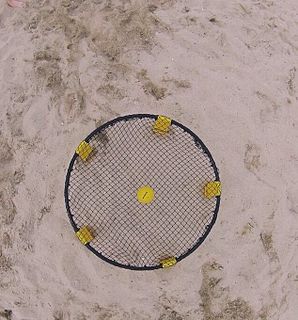
Roundnet is a net sport. The game is played between two teams, usually with two players each. Players initially line up around a small trampoline-like net at the start of a point. The game starts with a serve from one team to another, and teams alternate hitting the ball back to the net, and ends when the ball falls to the ground or an infraction occurs.
Snow volleyball is a winter team sport played by two teams of three players on a snow court divided by a net. The objective of each team is to score points by sending a ball over the net so as to ground it on the opponent's court, and to prevent the same effort by the opponent. A team is allowed up to three touches to return the ball across the net, and individual players may not touch the ball twice consecutively.











